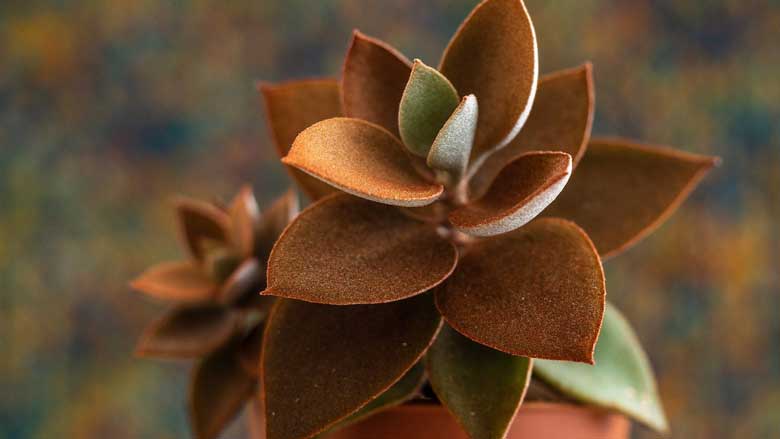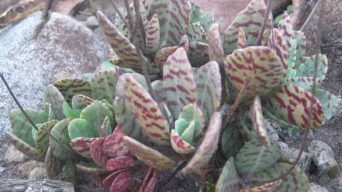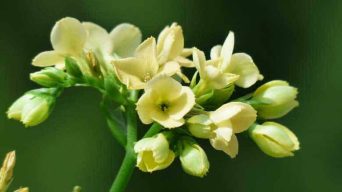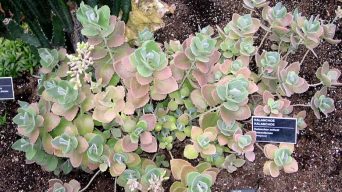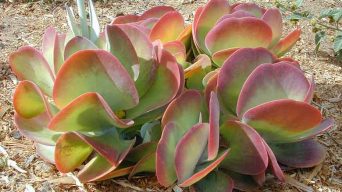The Kalanchoe orgyalis ‘Copper Spoons’ succulent plant is a slow-growing, easy to care for plant that can be propagated from cuttings, leaves, and offsets.
Copper Spoons plants are also one of the most beautiful Kalanchoes you’ll find!
This blog post will show you how to take care of your Kalanchoe orgyalis ‘Copper Spoons’ and propagate it so that you can enjoy this wonderful succulent for years.
Overview
Kalanchoe orgyalis, commonly known as Copper Spoons, is a flowering plant in the Crassulaceae family native to Madagascar.
Besides being known as the Copper Spoons plant, this succulent is also sometimes referred to as:
- Cinnamon Bear
- Leather Plant
- Shoe Leather Kalanchoe
- Kalanchoe antanosiana
The Kalanchoe orgyalis ‘Copper Spoons’ is a slow-growing shrub that grows up to 6 feet (1.8 m) tall but is usually seen as a smaller succulent.
This Kalanchoe plant has spoon-shaped leaves that fold upward from the middle.
The undersides of the succulent leaves are bronze to gray, while the top side has a reddish-brown color like that of copper.
The flowers are yellow and bloom in clusters on the ends of branches from late winter to early spring.
How To Care for Kalanchoe Orgyalis ‘Copper Spoons’
Kalanchoe orgyalis care is not too difficult, but they do require some care to thrive.
The following are the main points to provide proper care for a Kalanchoe orgyalis ‘Copper Spoons’ succulent.
Sun Exposure & Light Requirements
Kalanchoe orgyalis should be grown in a location that receives either full sun or partial shade.
It will thrive outdoors in dry climates that receive either full sun or partial shade.
Kalanchoe orgyalis should be placed near a window with ample bright light exposure when grown indoors.
A south-facing window is best, but Copper Spoons plants will also grow indoors near a west-facing window.
The plant should not be in complete shade on any side and needs at least six hours of direct sunlight per day.
It can be grown indoors in cooler climates as long as it is near a window that receives plenty of light.
Additionally, kalanchoe orgyalis should not get any direct sunlight during the hottest parts of the day, or it will scorch its leaves.
Watering Requirements
The Kalanchoe orgyalis ‘Copper Spoons’ succulent plant requires a fair amount of water.
Water the Kalanchoe orgyalis about once a week and in between when it feels dry to the touch.
Care must be taken not to overwater the Kalanchoe orgyalis, as this can lead to root rot.
In heavy rain, allow extra time before watering to prevent over-saturation and subsequent root damage due to excess moisture.
Soil Requirements
The Kalanchoe orgyalis ‘Copper Spoons’ plant is a succulent that will thrive in the following soil conditions: well-draining, desert sand; loam; and cactus potting mix.
Kalanchoe plants like sandy soil with great drainage, so it’s best to use a porous material such as perlite for when you’re planting them into pots.
The Kalanchoe orgyalis ‘Copper Spoons’ plant will also do well in a potting mixture that includes some sand, loam, and peat moss.
Sand is best for Kalanchoes because they need good drainage- too much soil means not enough oxygen reaches the roots, leading to root rot.
Sand helps with this because it provides excellent drainage without blocking off the necessary air supply like other heavier types of soil might.
If you’re planting your Kalanchoe outdoors, make sure it has at least one inch of mulch on top of its soil to prevent weeds from sprouting up around the base and robbing it of vital water and nutrients.
Temperature and Humidity
Kalanchoe orgyalis prefers to be grown in a temperature range of 50-90 degrees Fahrenheit.
The Kalanchoe orgyalis also prefer a humidity range of 50-90%.
Copper Spoons should never be exposed to temperatures below 40 degrees Fahrenheit for extended periods, as this will cause the leaves on the Kalanchoe to turn black and die.
Fertilizing
Fertilizing Kalanchoe orgyalis is not necessary.
But if you want to fertilize the plants, then it’s recommended that you use a liquid fertilizer at half-strength during the growing season.
This will make Copper Spoons plants grow faster and more vigorously.
You can also use a slow-release fertilizer for Kalanchoe, applied about a month before the plants are due to be repotted.
Lastly, you can use granular fertilizer around Kalanchoes planted in large containers or pots with drainage holes at the bottom.
Potting and Repotting
Kalanchoe orgyalis ‘Copper Spoons’ plants are grown in well-drained soil and need to be repotted when they have outgrown their container.
Kalanchoes prefer containers with drainage holes at the bottom so that excess water can drain away from where the roots originate.
A kalanchoe orgyalis ‘Copper Spoons’ soil should always contain some organic material to help retain moisture levels while also providing nutrients for healthy growth.
The Kalanchoe orgyalis ‘Copper Spoons’ plant is best potted in a clay pot that is porous enough for good drainage.
Pruning
Kalanchoe orgyalis ‘Copper Spoons’ have a slow growth rate, so pruning is not recommended.
You should only prune Kalanchoe orgyalis ‘Copper Spoons’ if it is necessary to keep its size manageable.
You can remove leaves if they are yellowing, wilting, and older, dying stems to encourage new growth.
The Kalanchoe orgyalis will continue to grow from the center of its rosette pattern. So it is not necessary to prune back this succulent for shape unless you want a smaller plant.
Pests and Diseases
Kalanchoe orgyalis plants are not prone to any major pests and diseases.
However, they are known to be susceptible to powdery mildew if the plant is overwatered.
If this occurs, it can cause some spotting on the leaves, eventually leading to small patches of dead cells that take away from the overall appearance.
To avoid this situation, make sure Kalanchoes have enough airflow in their environment and a well-draining soil mix.
These factors significantly prevent Kalanchoe succulents from getting sick because of too much water retention within their tissues.
Copper Spoons can also develop aphids, which are tiny insects that suck the plant’s sap.
If you notice a kalanchoe succulent with aphids, it is best to remove them by picking or spraying off these pests using insecticidal soap.
Aphid damage can lead to deformed leaves and stunted growth if left unchecked for too long.
How to Care for Kalanchoe Orgyalis in Winter
Kalanchoe orgyalis ‘Copper Spoons’ winter care is simple to maintain its health.
The most important things to do during the winter are:
- Move Kalanchoe orgyalis to a warm, bright spot that is close to an east-facing window.
- Bring Kalanchoe orgyalis indoors for the winter.
- Keep it at 45 degrees Fahrenheit and don’t let it freeze.
- Keep it properly hydrated and provide water when the Kalanchoe orgyalis roots are dry.
- Keep it out of drafts.
- Protect Kalanchoe orgyalis from frost by covering it with a piece of a burlap sack, matting, or other material to shield the plant and help retain the heat in the air around its leaves.
Move Kalanchoe back outside when temperatures are higher than 50 degrees Fahrenheit at night (or day) so that it can take advantage of natural light without getting damaged by cold weather.
How To Propagate Kalanchoe Orgyalis ‘Copper Spoons’
Kalanchoe orgyalis ‘Copper Spoons’ can be propagated from cuttings, leaves, and offsets.
Cuttings
To propagate Kalanchoe orgyalis ‘Copper Spoons’ from cuttings, take leafless stems between 12 and 20cm.
Remove the leaves from one end of the stem and allow them to callous it for a few days.
Place it in a well-drained planting media such as cactus mix soil or perlite.
The cutting should be at least three inches deep into moist soil to not dry out before roots form if put outside during warm seasons.
Place the container where it can get indirect sunlight for about four hours a day without exposure to direct sunlight.
It will take about four weeks for kalanchoe orgyalis ‘Copper Spoons’ to root.
Once a kalanchoe orgyalis grows roots, the cutting should be planted into the growing medium.
Kalanchoes are best propagated in spring and early summer when they have healthy growth rates.
Leaves
To propagate Kalanchoe orgyalis ‘Copper Spoons’ from leaves, you will need to remove a leaf from the plant.
Allow the leaf cuttings to callous over for a few days, and then plant the leaf in the soil.
Cover it with about an inch of dirt, pat down firmly, water gently (so as not to disturb the callous), and place it under bright light.
In some cases, you will need to wait up to two weeks before seeing signs of new growth.
After you see new growth, you will need to transplant the plant into a pot of its own.
Offsets
To propagate Kalanchoe orgyalis ‘Copper Spoons’ from offsets, you will need to remove an offset from the plant.
You should then allow it to dry over for a few days and place it in the soil until new growth appears.
The new growth will be an individual succulent, separate from the mother plant.
Once the offspring is big enough to take care of itself and has at least four leaves, you should pot it up in its own container.
Is the Kalanchoe Orgyalis ‘Copper Spoons’ Toxic?
The Kalanchoe orgyalis ‘Copper Spoons’ plant can be toxic to humans and animals, so it should not be consumed.
It should also be grown in an area where animals and children cannot access it.
Final Thoughts
Kalanchoes are one of the most popular succulents for a variety of reasons.
They’re great indoor plants that propagate easily from cuttings. Their attractive foliage makes them perfect accent pieces to any home or office space.
As a variety of the Kalanchoe genus, the Kalanchoe orgyalis ‘Copper Spoons’ succulent plant is sure to be a favorite of any succulent-lover.
With its attractive leaves, ease of propagation, and care requirements that are easy for anyone to follow, this Kalanchoe is one you’ll grow happily ever after with!

